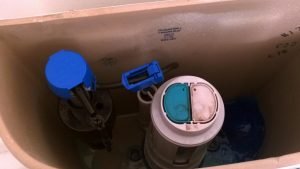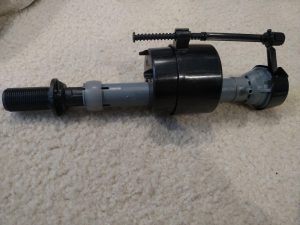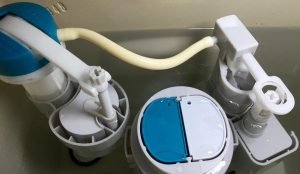3 Ways to Adjust a Dual Flush Toilet Water Level
Last Updated on July 7, 2023 by toilethaven
How do you adjust the water level in a dual-flush toilet?
A dual-flush toilet flushing mechanism works differently from that of a single-flush toilet. Dual flush toilets mostly use flush buttons instead of a trip level and do not use the ordinary toilet flapper with a lift chain.
The water level inside a dual flush toilet tank will also affect the water level inside the bowl. If the toilet tank water level is too low, it also means the water level in the bowl will also be low and vice versa.
A low water level in a dual flush toilet tank/bowl is a sign that the fill valve is faulty, the toilet float is not adjusted correctly, the refill tube is not clipped on the overflow tube, the toilet bowl is cracked, or the vent stack is clogged.
Adjusting the water level in a dual flush toilet is, however, a simple task that only needs a screwdriver to fix. You might, however, need to replace the fill valve if it is faulty.
To adjust the water level in a dual flush toilet, remove the tank lid and adjust the position of the toilet float till you get the desired water level. If the problem is caused by a defective toilet fill valve, you will need to replace it.

It is first important to ensure that the low water level in your toilet does not result from the leak. A running toilet will continuously drain the water in the tank inside the bowl and will most likely ghost-flush.
Put some food color inside the tank, and if the same appears inside the bowl, you have a running toilet. I have written a whole post on how to fix a running dual-flush toilet. Read it here.
A low water lever in a dual flush toilet tank is characterized by a low water level in the bowl and a weak flushing toilet. A high water level is characterized by a running or overflowing toilet.
Before you know how to adjust a dual flush toilet float, it is even better if you first understand how a dual flush toilet works. This will make fixing it easy and quick.
How Dual Flush Toilets Work

Push Button Valve Assembly
In a single flush toilet, the toilet handle is connected to a lift chain which in return is connected to the toilet flapper. During flushing, the chain lifts the flapper off, and the water moves through the flush valve to the bowl.
A dual-flush toilet has no lift chain. A solid push-button assembly is installed in the middle of the tank. It has two buttons, most in white and blue. One button is for the full flush, while the other one is for the half flush.
When you push down one of the buttons, the flush valve seal is lifted off, and water then moves down to flush the toilet.
Toilet Fill Valve

The toilet fill valve of a dual flush toilet does not differ from those of a single flush toilet. It is responsible for filling the toilet tank with water after every flush. A toilet fill valve is connected from the bottom of the tank to the water supply line.
Toilet Float
The float cup, also known as a floating cylinder, is a cylindrical cup connected to the vertical body of the fill valve assembly. It regulates the opening and closing of the fill valve.
The float cup also regulates the level of water in the toilet tank. If it is set too low, the level of the water in the tank will be low and hence low flushing power. If it is set to high, the water level in the toilet tank will be too high. If it goes higher than the overflow tube, it will start running back to the bowl, causing your toilet to run throughout.
Refill tube
The refill tube is a small tube connected from the fill valve to the overflow tube. After flushing and as the fill valve is refilling the tank, the refill tube sends a small amount of water back to the bowl through the overflow tube.
The water remains at the bottom of the bowl. This water prevents sewer gases from coming up into the bathroom and the entire house.
If the toilet is not filling up correctly, sufficient water will not be sent back to the bowl and hence a low water level in the toilet bowl.
Overflow tube
The overflow tube is a cylindrical tube in the middle of the toilet tank. If the toilet bowl is continuously filling with water, it prevents the flooding of the bathroom and the entire house by sending the excess water back into the bowl. If, therefore, your toilet can’t stop running, this is normally the problem.
How to Adjust the Water Level in a Dual Flush Toilet
There are several ways to adjust the water level in a dual-flush toilet, depending on what is causing the problem.
1. Adjust the Toilet Float
- Start by removing the toilet tank lid. Note that this piece is made of porcelain and could easily crack. Place it in a safe place.
- Note the level of water inside the tank. Ideally, the water level inside the tank should be about a half-inch below the top of the overflow tube. If it is lower than that or higher, you need to adjust it.
- Look for a long plastic adjustment screw attached to the toilet float and toilet fill valve. To adjust the water level in the tank, you will need to turn this screw.

- Using a screwdriver, turn the adjustment counterclockwise to increase the water level in the tank and clockwise to lower the water level. Turn the screw slowly, as you do not want the water level to increase suddenly. You want to make sure that it is ¼ to ½ inch below the overflow tube.
- Make sure that the refill tube is also properly clipped on the overflow tube and in good condition. One of the reasons some toilet bowls have a low water level is that the refill tube is not correctly clipped. Make sure that it is not also too long inside the overflow tube that it is siphoning water out of the bowl.
2. Replace the Fill Valve
Sometimes the low water level in a dual flush toilet is caused by a faulty fill valve. This is especially the case in areas with hard water, where the fill valve is blocked by mineral deposits and other debris.
It could also be that the toilet fill valve’s seal is worn out, causing the toilet to run throughout. Fixing a toilet fill valve is possible, but the best thing to do is to replace it with a new one.
Toilet fill valves are cheap and easy to install. I have written a detailed post on how to replace a toilet fill valve. Read it here.
3. Unclog the Toilet Drain/Vent Stack
A partially clogged toilet or a blocked vent stack will slowly siphon water out of your toilet bowl. This happens regardless of whether it is a single-flush or dual-flush toilet.
Unclogging the toilet and vent stack will quickly fix this problem. I have also written a blog post on how to go about this problem. Find it here.